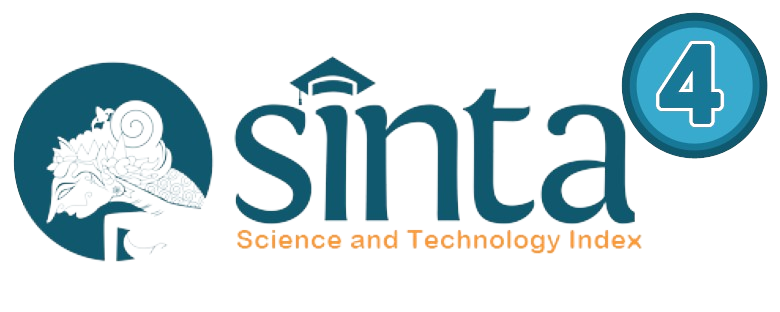Author Guidelines
Instructions for Authors (Author Guideline)Jurnal DIGIT : Digital of Information TechnologyGeneral InstructionsJurnal DIGIT contains scientific articles on topics relevant to the field of computer science in the form of research results, simulations and the development of fundamental concepts. Articles proposed for publication in the DIGIT Journal must be articles that have never been published in other scientific magazines. Articles can be written in Indonesian or English using good and correct written language rules.
The article is written in manuscript form in MS Word with A4 page size (210 x 297 mm) with a left margin of 2.5 cm, a top margin of 2.5 cm, a right margin of 2.5 cm, and a bottom margin of 2.5 cm. Articles are written in single-column format. It is recommended to only use the writing facilities provided in MS Word (bold, italics, subscript, superscript, equation, etc.). All parts of the text in the manuscript are written using Times New Romans 10 pt font and single spaced with spacing between paragraphs (spacing after) 10 pt
Special InstructionsThe manuscript begins with the Title, Author's Name, Author's Address, Abstract and Keywords followed by a content section consisting of Introduction, Research Methods (Model Development), Results and Discussion, Conclusion, Acknowledgments (if any), List of Notations (if any) , and Bibliography. The sequence number and image name are written at the bottom of the image, while the table number and table name are written at the top of the table. Please ensure that the quality and size of the images presented are large enough to produce good print quality. Please do not frame the image. This will make it easier for the editor to edit and format the writing later.
- Title, Author's Name, Author's Address, Corresponding Author
- The title of the article is written concisely but informatively. It is advisable not to use abbreviations and formulas that are not widely known.
- The names of all authors are written below the article title in full but without title. At the end of each name a superscript letter is given to identify the author's address. Apart from that, it is also necessary to identify the author responsible for the correspondence.
- The author's address is written below all author names starting with the superscript letter corresponding to each author's name.
- The correspondence address is written in the foot-note section on the page containing the author's name. The address must contain a complete and clear postal address. Apart from that, it also includes e-mail, telephone and fax addresses.
Abstract and Keywords
- The abstract is written concisely; contains the aims/objectives, results and conclusions that you want to highlight. Abstract length is approximately 150-200 words. It is recommended that abstracts do not contain abbreviations or formulas that are not widely known.
- Directly below the abstract text, write a maximum of 5 (five) appropriate selected keywords, each separated by a comma (,).
- The abstract and key words are written each in 2 (two) languages, namely Indonesian and English.
Introduction In the introductory section, the background of the research/writing is presented, a brief literature review which explains the state of the art of the research and the objectives of the research/writing. Research Methods In this section, the methods or models or research stages that will be carried out systematically are presented. Each part of the method or model or stage of the research to be carried out must be explained clearly (if necessary based on references from other research). If the submitted manuscript produces output in the form of development in the form of software/hardware/models, it is necessary to provide a description of the proposed output and how the output is evaluated/used. Results and Discussion In this section, the research results obtained systematically and constructively are presented, accompanied by a comprehensive discussion that supports the research objectives and strengthens the conclusions. Conclusions This section briefly presents the main conclusions from the results obtained.
Writing references All reference items use IEEE style. Reference item numbers are written in square brackets (e.g. [1]). When referring to a reference item, use the reference number, as in [2]. Do not use “Ref. [3]” or “Reference [3]” except at the beginning of a sentence, for example “Reference [3] indicates …”. If using multiple references, each number is separated by a bracket (for example [2], [3], [4]–[6]). Examples of reference items for different categories: example of a book in [1] example of a journal article in [2] example of a conference paper in [3] example of a patent in [4] example of a website in [5] [1] S. M. Metev and V. P. Veiko, Laser Assisted Microtechnology, 2nd ed., R. M. Osgood, Jr., Ed. Berlin, Germany: Springer-Verlag, 1998. [2] J. Breckling, Ed., The Analysis of Directional Time Series: Applications to Wind Speed and Direction, ser. Lecture Notes in Statistics. Berlin, Germany: Springer, 1989, vol. 61. [3] S. Zhang, C. Zhu, J. K. O. Sin, and P. K. T. Mok, “A novel ultrathin elevated channel low-temperature poly-Si TFT,” IEEE Electron Device Lett., vol. 20, pp. 569–571, Nov. 1999. [4] M. Wegmuller, J. P. von der Weid, P. Oberson, and N. Gisin, “High resolution fiber distributed measurements with coherent OFDR,” in Proc. ECOC’00, 2000, paper 11.3.4, p. 109. [5] R. E. Sorace, V. S. Reinhardt, and S. A. Vaughn, “High-speed digital-to-RF converter,” U.S. Patent 5 668 842, Sept. 16, 1997. [6] (2002) The IEEE website. [On line]. Available: http://www.ieee.org/ [7] M. Shell. (2002) IEEEtran homepage on CTAN. [On line]. Available: http://www.ctan.org/tex-archive/macros/latex/contrib/supported/IEEEtran/ [8] FLEXChip Signal Processor (MC68175/D), Motorola, 1996. [9] “PDCA12-70 data sheet,” Opto Speed SA, Mezzovico, Switzerland. [10] A. Karnik, “Performance of TCP congestion control with rate feedback: TCP/ABR and rate adaptive TCP/IP,” M. Eng. thesis, Indian Institute of Science, Bangalore, India, Jan. 1999. [11] J. Padhye, V. Firoiu, and D. Towsley, “A stochastic model of TCP Reno congestion avoidance and control,” Univ. of Massachusetts, Amherst, MA, CMPSCI Tech. Rep. 99-02, 1999.
Article Loading in DIGIT Journal Manuscripts, in MS Word format, which have been written in accordance with the provisions above are sent via OJS Digit Journal. Manuscripts can also be sent via the editorial e-mail address (more recommended). Apart from that, please also attach the Personal Data of the Corresponding Author which includes the author's name (complete with academic degree), agency where he works, correspondence address, e-mail address and telephone number. Manuscripts that have been accepted by the Journal editorial team will go through a review process by the Editorial Board and Bestari Partners. By considering the results of the review, the editor has the full right to accept or reject a manuscript for publication.
Contains scientific articles on topics relevant to the field of computer science in the form of research results, simulations and the development of fundamental concepts. Articles proposed for publication in the DIGIT Journal must be articles that have never been published in other scientific magazines. Articles can be written in Indonesian or English using good and correct written language rules.
Copyright Notice
Users are permitted to read, download, copy, distribute, print, search, or link to full text articles in this journal without seeking prior permission from the publisher or author. This journal is licensed under a Creative Commons Attribution-ShareAlike 4.0 International License, which permits sharing, copying and redistributing the material in any medium or format as long as you give appropriate credit to the original author and the source, provide a link to the Creative Commons license. If you remix, transform, or build on the material, you must distribute your contributions under the same license as the original. The licensor cannot take away this freedom as long as you follow the terms of the license. To view a copy of this license, visit this permanent link.
Authors publishing in this journal agree to the following terms:
- The authors retain copyright and grant the journal first publication rights with the work simultaneously licensed under the Creative Commons Attribution-ShareAlike 4.0 International License which allows others to share the work with acknowledgment of the work's authorship and initial publication in this journal.
- Authors may make separate additional contractual arrangements for non-exclusive distribution of the published journal version of the work (e.g., posting it to an institutional repository or publishing it in a book), with initial acknowledgment of publication in this journal.
- Authors are permitted and encouraged to post their work online (e.g., in institutional repositories or on their websites) before and during the submission process, as this can result in productive exchange, as well as earlier and greater citation of the published work (See Effects of Access Open).
You are free to:
Share — copy and redistribute the material in any medium or format.
Adapt — remix, change, and build on material for any purpose, even commercially.
The licensor cannot take away this freedom as long as you follow the terms of the license.

This work is licensed under a Creative Commons Attribution-ShareAlike 4.0 International License.















